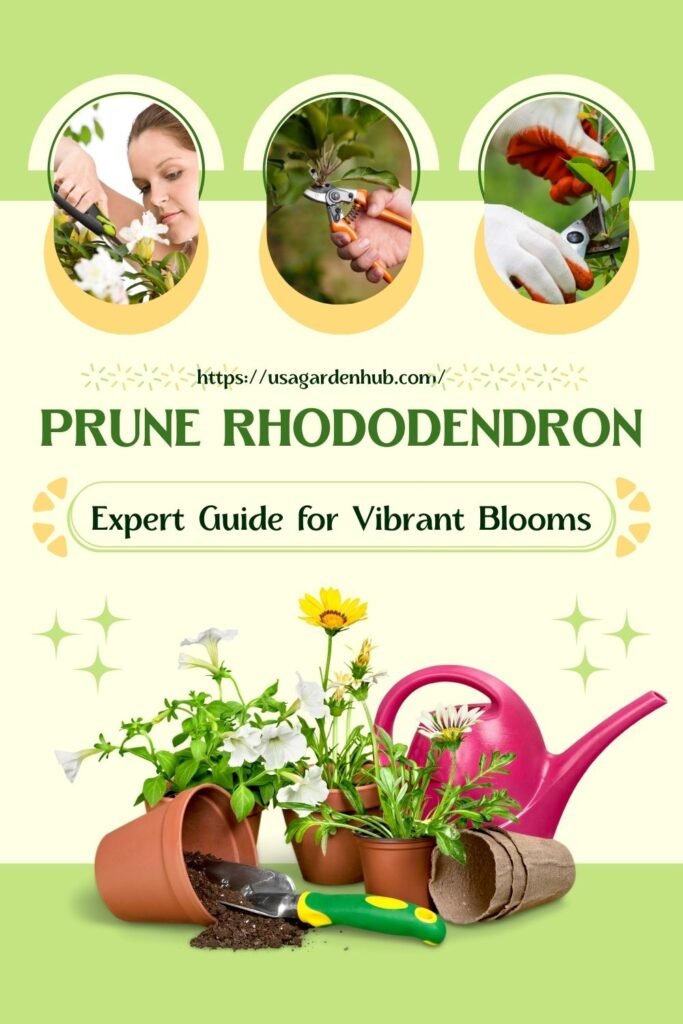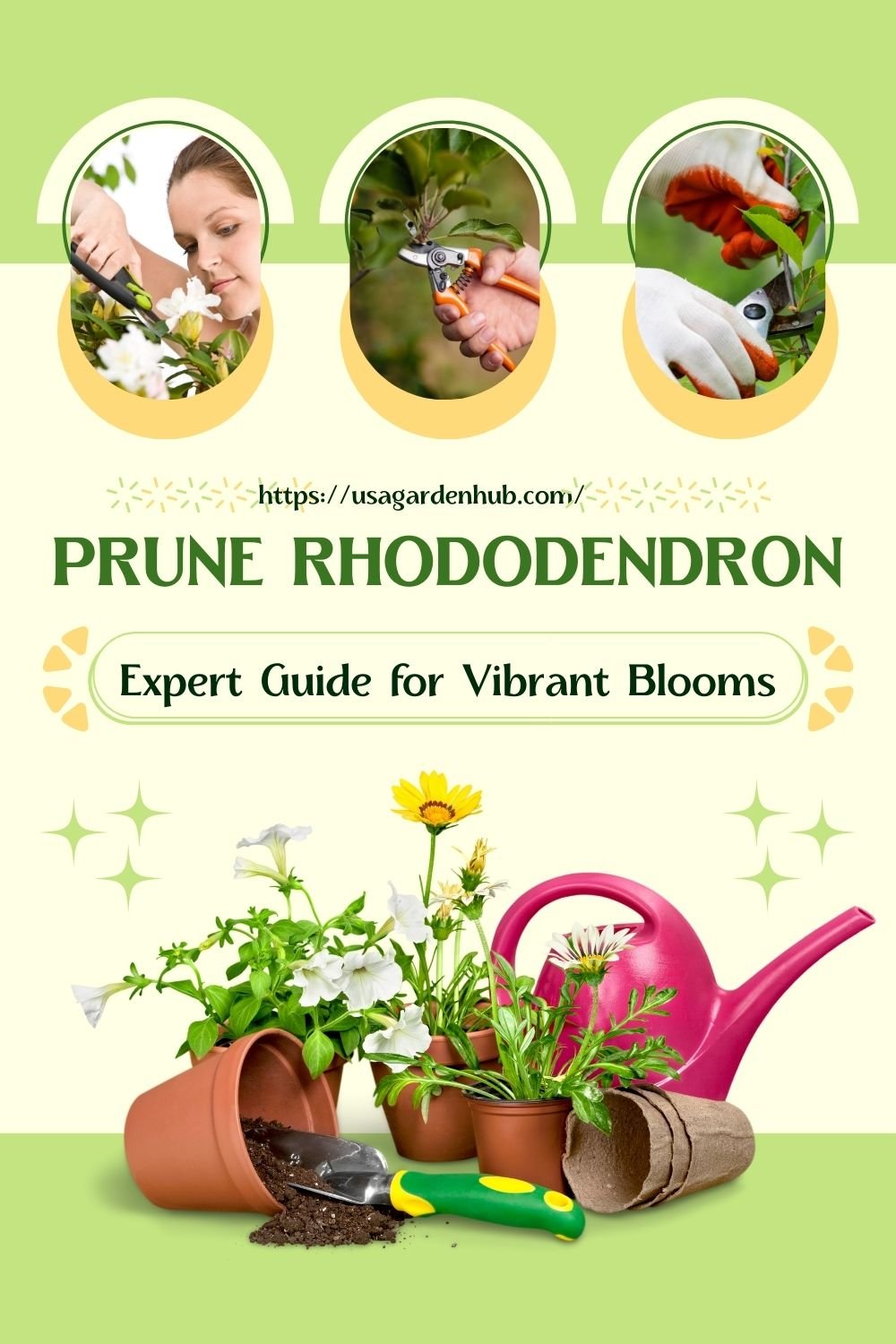Learn how to prune rhododendron like a pro with our expert 2024 guide. Discover timing, techniques, and tools for healthier plants and abundant blooms. Perfect for all gardeners!
Pruning a rhododendron is a crucial gardening skill that enhances the plant’s health, shape, and flowering potential. When done correctly, pruning can rejuvenate an old rhododendron, control its size, and promote lush growth. This comprehensive guide will walk you through the step-by-step process of pruning rhododendrons, providing expert tips and insights for success in your garden.
As a horticulturist with over two decades of experience in ornamental shrub care, I’m excited to share my knowledge on pruning rhododendrons. Let’s dive into the art and science of shaping these beautiful flowering shrubs!
Why Prune Rhododendrons?

Before we get into the how-to, let’s consider the benefits of pruning rhododendrons:
- Improve air circulation and light penetration
- Remove dead, damaged, or diseased branches
- Control size and shape
- Encourage fuller, bushier growth
- Enhance flowering performance
Now, let’s explore the process of pruning rhododendrons step by step.
Step-by-Step Guide to Pruning Rhododendrons
1. Determine the Right Time to Prune
Why It’s Important: Timing is crucial for minimizing stress on the plant and ensuring robust regrowth.
When to Do It:
- Light pruning can be done anytime
- Major pruning should be done in late winter or early spring, just before new growth begins
- Avoid pruning after mid-summer to prevent interfering with next year’s blooms
2024 Update: New research suggests that climate change may be shifting optimal pruning times in some regions. Check with your local extension office for the most up-to-date recommendations.
Pro Tip: If you must prune after flowering, do so within 3 weeks of bloom time to avoid removing next year’s buds.
2. Gather the Right Tools
Why It’s Important: Proper tools ensure clean cuts and minimize damage to the plant.
What You’ll Need:
- Bypass pruners for small branches (up to 1/2 inch)
- Loppers for medium branches (1/2 to 1 1/2 inches)
- Pruning saw for larger branches
- Disinfectant (rubbing alcohol or 10% bleach solution)
2024 Innovation: New ergonomic pruning tools with rotating handles are gaining popularity, reducing hand fatigue during extensive pruning sessions.
Pro Tip: Clean and disinfect your tools between cuts to prevent the spread of diseases.
3. Remove Dead, Damaged, or Diseased Wood
Why It’s Important: This improves plant health and appearance.
How to Do It:
- Identify branches that are brown and brittle, or show signs of disease
- Cut these branches back to healthy wood or to their point of origin
- Make cuts at a 45-degree angle just above a leaf node or lateral branch
2024 Trend: Advanced plant disease detection apps are helping gardeners identify problematic branches more accurately.
Pro Tip: If you’re unsure if a branch is dead, scrape the bark lightly. Green underneath indicates live wood.
4. Thin Out Dense Areas
Why It’s Important: Improves air circulation and light penetration, reducing disease risk.
How to Do It:
- Remove up to 1/3 of the older, thicker branches, cutting them back to the main stem
- Focus on branches that cross or rub against each other
- Maintain the natural shape of the plant while thinning
2024 Research: Studies show that strategic thinning can increase rhododendron resilience to climate stress.
Pro Tip: Step back frequently to assess your progress and maintain balance.
5. Shape the Plant
Why It’s Important: Maintains an attractive form and controls size.
How to Do It:
- Cut back longer branches to shape the plant
- Make cuts just above a whorl of leaves or a lateral branch
- Avoid shearing, which can create an unnatural appearance
2024 Trend: Naturalistic pruning techniques that mimic wild growth patterns are becoming popular in landscape design.
Pro Tip: For a more natural look, vary the height of your cuts slightly.
6. Rejuvenate Overgrown Plants
Why It’s Important: Revitalizes old or neglected rhododendrons.
How to Do It:
- Cut back all stems to about 12-15 inches from the ground
- Do this in late winter before new growth begins
- Be prepared for the plant to take 2-3 years to fully recover
2024 Update: New rapid-recovery fertilizers are being developed to support rhododendrons after hard pruning.
Pro Tip: Consider rejuvenation pruning for only 1/3 of the plant each year over three years for a less drastic approach.
7. Care for the Plant Post-Pruning
Why It’s Important: Supports recovery and promotes healthy new growth.
How to Do It:
- Water deeply after pruning
- Apply a layer of mulch around the base of the plant
- Fertilize with a balanced, slow-release fertilizer in spring
2024 Innovation: Smart irrigation systems that adjust watering based on plant stress levels are becoming more accessible for home gardeners.
Pro Tip: Monitor the plant closely in the weeks following pruning, and provide extra care during dry or hot periods.
Best Practices for Rhododendron Pruning
To ensure the best results when pruning rhododendrons:
- Never remove more than 1/3 of the plant in a single season (except for rejuvenation pruning).
- Make clean cuts to minimize damage and disease risk.
- Maintain the plant’s natural form unless you’re creating a specific shape for formal gardens.
- Prune selectively rather than shearing to maintain the plant’s health and natural beauty.
- Be patient – rhododendrons may take time to respond to pruning.
Cultivating Beauty Through Pruning
Pruning rhododendrons is both a science and an art. By mastering these techniques, you’ll be able to maintain healthy, vibrant shrubs that provide stunning displays of flowers year after year. Remember, each plant is unique, and it may take some practice to perfect your pruning skills.
Don’t be afraid to experiment and learn from each pruning session. With time, you’ll develop an intuitive understanding of how your rhododendrons respond to different pruning approaches.
For more information on rhododendron care and gardening techniques, visit resources like the American Rhododendron Society or your local botanical garden. Happy pruning, and may your rhododendrons flourish with vibrant beauty!
For more gardening tips and plant care guides, visit usagardenhub.com.


1 thought on “How To Prune A Rhododendron : Expert Guide for Vibrant Blooms”